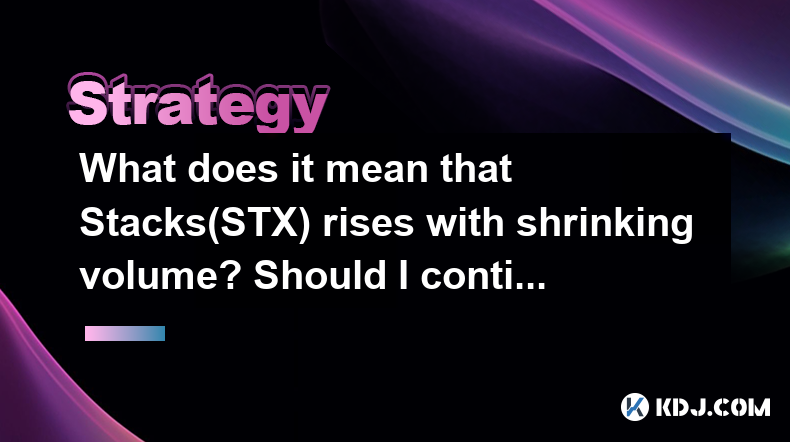-
 bitcoin
bitcoin $121833.232455 USD
-0.63% -
 ethereum
ethereum $4394.437030 USD
-2.00% -
 tether
tether $1.000570 USD
0.04% -
 bnb
bnb $1255.553465 USD
-3.73% -
 xrp
xrp $2.814944 USD
-1.59% -
 solana
solana $221.835346 USD
-2.40% -
 usd-coin
usd-coin $0.999869 USD
0.01% -
 dogecoin
dogecoin $0.249495 USD
-1.32% -
 tron
tron $0.336905 USD
-1.24% -
 cardano
cardano $0.816464 USD
-1.69% -
 chainlink
chainlink $22.130946 USD
-1.27% -
 hyperliquid
hyperliquid $44.208522 USD
-3.46% -
 ethena-usde
ethena-usde $1.000521 USD
0.02% -
 sui
sui $3.422897 USD
-2.51% -
 stellar
stellar $0.380164 USD
-1.31%
What does it mean that Stacks(STX) rises with shrinking volume? Should I continue to hold or take profits?
Rising STX price with shrinking volume may indicate waning interest or a potential reversal; investors should assess market conditions and their goals before deciding to hold or take profits.
May 02, 2025 at 09:36 am

The phenomenon of Stacks (STX) rising with shrinking volume is a nuanced topic that requires a detailed analysis to understand its implications for investors. This article will delve into the meaning behind this market movement, explore possible reasons, and discuss whether investors should continue to hold their STX or take profits.
Understanding Price and Volume Dynamics
In the cryptocurrency market, price and volume are two critical indicators that traders use to gauge the health and direction of an asset. Typically, when a cryptocurrency's price increases, it is accompanied by a rise in trading volume, indicating strong buyer interest and market participation. Conversely, a rising price with shrinking volume suggests that the upward movement may be losing momentum.
What Does Rising STX Price with Shrinking Volume Indicate?
When Stacks (STX) experiences a price increase alongside a decrease in trading volume, it can signal several things:
- Decreased Market Interest: The shrinking volume indicates that fewer traders are actively buying STX, which might suggest waning interest in the asset.
- Potential Reversal: A rising price with declining volume can be a precursor to a price reversal, as the lack of volume may indicate that the upward trend is not supported by strong buying pressure.
- Consolidation Phase: It could also mean that STX is entering a consolidation phase, where the price is stabilizing after a period of growth.
Possible Reasons for Shrinking Volume
Several factors could contribute to the shrinking volume during a price increase for STX:
- Profit-Taking: Early investors might be taking profits, leading to reduced buying pressure.
- Market Sentiment: Changes in overall market sentiment towards cryptocurrencies or specific developments related to Stacks could influence trading activity.
- Liquidity Issues: If there are fewer orders on the market, it can result in lower volume, even if the price is still rising.
Should You Hold or Take Profits?
Deciding whether to hold or take profits with STX in this scenario involves considering several factors:
- Investment Goals: Your decision should align with your long-term investment goals and risk tolerance. If you are in STX for the long haul, you might choose to hold despite the shrinking volume.
- Market Analysis: Conducting a thorough market analysis, including technical and fundamental analysis, can help you determine if the current trend is likely to continue or reverse.
- Portfolio Diversification: Consider the role of STX in your overall portfolio. If it constitutes a significant portion, taking some profits might be prudent to rebalance your holdings.
Technical Analysis Insights
Technical analysis can provide valuable insights into the behavior of STX. Here are some key indicators to consider:
- Moving Averages: If STX is trading above its moving averages but the volume is declining, it might indicate weakening bullish momentum.
- Relative Strength Index (RSI): An RSI that is not in overbought territory despite the rising price could suggest that the upward movement is not as strong as it appears.
- Volume Profile: Analyzing the volume profile can help identify key support and resistance levels, which can inform your decision to hold or sell.
Fundamental Analysis Considerations
Fundamental analysis is equally important when deciding whether to hold or take profits with STX:
- Project Developments: Keep an eye on any new developments or updates from the Stacks team. Positive news can support a continued upward trend, even with lower volume.
- Market Position: Assess the competitive landscape and Stacks' position within it. If STX is gaining ground in its niche, it might justify holding.
- Adoption and Use Cases: Increasing adoption and real-world use cases for Stacks can bolster confidence in its long-term potential.
Practical Steps for Decision-Making
If you are contemplating whether to hold or take profits with STX, consider the following practical steps:
Review Your Investment Thesis: Go back to your initial reasons for investing in STX. Have those fundamentals changed?
Set Clear Exit Points: Determine specific price levels at which you would take profits or cut losses. This can help you make decisions more objectively.
Monitor Market Conditions: Stay updated on broader market conditions, as they can impact STX's performance.
Use Stop-Loss Orders: Implementing stop-loss orders can help protect your investment from significant downturns.
Consult with Other Investors: Engaging with the STX community can provide additional perspectives and insights that might influence your decision.
Frequently Asked Questions
Q: How can I tell if the shrinking volume is a temporary phenomenon or a sign of a longer-term trend?A: To determine whether the shrinking volume is temporary or indicative of a longer-term trend, monitor STX's price and volume over an extended period. Look for patterns such as consistent volume declines over weeks or months, which might suggest a longer-term trend. Additionally, keep an eye on news and developments related to Stacks, as these can influence trading activity.
Q: Are there specific technical indicators that I should focus on when analyzing STX's price and volume?A: Yes, several technical indicators can be particularly useful when analyzing STX's price and volume. The On-Balance Volume (OBV) indicator can help confirm the strength of the price trend based on volume changes. The Volume Weighted Average Price (VWAP) can provide insights into the average price at which STX has traded throughout the day, considering volume. Additionally, Bollinger Bands can help identify periods of low volatility, which might coincide with shrinking volume.
Q: How does the overall market sentiment affect STX's price and volume dynamics?A: Overall market sentiment plays a significant role in STX's price and volume dynamics. Positive sentiment towards cryptocurrencies can drive increased trading activity and higher volumes, supporting price increases. Conversely, negative sentiment can lead to reduced trading activity and lower volumes, potentially causing price declines. Monitoring sentiment indicators such as social media trends, news sentiment, and market fear and greed indices can provide valuable context for STX's performance.
Q: Can external factors like regulatory news impact STX's volume and price movements?A: Yes, external factors such as regulatory news can significantly impact STX's volume and price movements. Positive regulatory developments can boost investor confidence, leading to increased trading volume and price appreciation. On the other hand, negative regulatory news can cause investors to pull back, resulting in lower volumes and potential price drops. Staying informed about regulatory changes and their potential impact on the cryptocurrency market is crucial for understanding STX's performance.
Disclaimer:info@kdj.com
The information provided is not trading advice. kdj.com does not assume any responsibility for any investments made based on the information provided in this article. Cryptocurrencies are highly volatile and it is highly recommended that you invest with caution after thorough research!
If you believe that the content used on this website infringes your copyright, please contact us immediately (info@kdj.com) and we will delete it promptly.
- Kuarden, Binance, and Coinbase: Navigating the Crypto Landscape in Style
- 2025-10-11 00:25:16
- LEGO Batman Turns 20: New Sets Celebrate a Legacy of the Dark Knight
- 2025-10-11 00:25:16
- HEMI, Dominari, and Digital Assets: Bridging Bitcoin to Wall Street, Ya Heard?
- 2025-10-11 00:30:01
- Cryptos, Mandala Chain, Layer 1: A Deep Dive into the KPG Presale and Beyond
- 2025-10-11 00:30:01
- Mandala Chain: Early Investors, Thriving Developer Ecosystem, and Polkadot Potential
- 2025-10-11 00:30:01
- zkSchellingCoin: Revolutionizing Trust-Minimized Data with ZK-Oracles
- 2025-10-11 00:30:17
Related knowledge

Practical parameter settings for a Bitcoin multi-timeframe moving average system
Sep 18,2025 at 10:54pm
Optimizing Timeframe Combinations for Bitcoin Trading1. Selecting appropriate timeframes is crucial when building a multi-timeframe moving average sys...

How can I filter out false breakouts in Dogecoin high-frequency trading?
Sep 22,2025 at 01:00am
Understanding False Breakouts in Dogecoin Trading1. A false breakout occurs when Dogecoin's price appears to move beyond a defined support or resistan...

Techniques for identifying tops and bottoms in the Bitcoin on-chain NVT model
Sep 20,2025 at 07:54pm
Understanding the NVT Model in Bitcoin Analysis1. The Network Value to Transactions (NVT) ratio is often described as the 'P/E ratio' of the cryptocur...

What does the surge in open interest in Bitcoincoin futures mean?
Sep 20,2025 at 11:18pm
Understanding the Surge in Dogecoin Futures Open Interest1. A surge in open interest within Dogecoin futures indicates a growing number of active cont...

How can I use the Ethereum USDT premium to gauge market sentiment?
Sep 18,2025 at 11:55pm
Understanding the Ethereum USDT Premium1. The Ethereum USDT premium refers to the price difference between USDT (Tether) traded on Ethereum-based plat...

What should I do if Ethereum staking yields decline?
Sep 20,2025 at 06:18am
Understanding the Causes Behind Declining Ethereum Staking Yields1. The Ethereum network transitioned to a proof-of-stake consensus mechanism with the...

Practical parameter settings for a Bitcoin multi-timeframe moving average system
Sep 18,2025 at 10:54pm
Optimizing Timeframe Combinations for Bitcoin Trading1. Selecting appropriate timeframes is crucial when building a multi-timeframe moving average sys...

How can I filter out false breakouts in Dogecoin high-frequency trading?
Sep 22,2025 at 01:00am
Understanding False Breakouts in Dogecoin Trading1. A false breakout occurs when Dogecoin's price appears to move beyond a defined support or resistan...

Techniques for identifying tops and bottoms in the Bitcoin on-chain NVT model
Sep 20,2025 at 07:54pm
Understanding the NVT Model in Bitcoin Analysis1. The Network Value to Transactions (NVT) ratio is often described as the 'P/E ratio' of the cryptocur...

What does the surge in open interest in Bitcoincoin futures mean?
Sep 20,2025 at 11:18pm
Understanding the Surge in Dogecoin Futures Open Interest1. A surge in open interest within Dogecoin futures indicates a growing number of active cont...

How can I use the Ethereum USDT premium to gauge market sentiment?
Sep 18,2025 at 11:55pm
Understanding the Ethereum USDT Premium1. The Ethereum USDT premium refers to the price difference between USDT (Tether) traded on Ethereum-based plat...

What should I do if Ethereum staking yields decline?
Sep 20,2025 at 06:18am
Understanding the Causes Behind Declining Ethereum Staking Yields1. The Ethereum network transitioned to a proof-of-stake consensus mechanism with the...
See all articles










































































